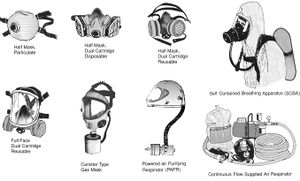Course:SPPH381B/Essay 3/Ensuring Personal Protective Equipment works: the Respirator example
Worksafe BC states that personal protective equipment (PPE) is a worker’s last defense against injury and death, when eliminating workplace hazards is not possible[1], and when engineering controls are not feasible[2]. This however, is not the case in most workplaces. A respirator is used to control worker exposure to airborne contaminants[3] and due to its nature and inherent lack of other controls, it does not eliminate the hazard from the workplace, it only serves to alleviate harm to the worker. There are many different types of respirators available for numerous occupational practices, and proper selection, fit, and maintenance must be taught to the worker in order to maximize the health benefits of the respirator. Respirators are typically used in one of three scenarios, during routine or regular exposure to processes, infrequent but predictable occasions where there is chemical exposure, or in an emergency[4]
Types of respirators

Common types of respirators include half face, full face, powered air-purifying respirator (PAPR), and self-contained breathing apparatus (SCBA). These masks all have assigned protection factors (APF) which determine the level of protection the individual receives from their mask. For example, an AFP value of 10 will reduce exposure to 1/10th the concentration of contaminant in the air[5]. Half- and full-faced masks are both equipped with filters on either side of the mouth that are specific to the airborne hazard. The cartridge inserted may have a filter to remove particles, charcoal, to remove chemicals, or a combination of both as well as other parts[6]. The difference between a half- and full-face mask is that a full-face mask has a face piece which protect the eyes and skin of the face whereas a half-face mask is only worn around the mouth. The powered air-purifying respirator employs a fan to blow air through the filter, the wearer must know what the hazard is and how much of it is in the air to make the correct filter selection[5]. A self-contained breathing apparatus is most often used by firefighters, it uses its own air tank so the wearer is not breathing any of the air from the environment, however they are very heavy and typically last an hour or less [5].
| Type of Respirator | APF | Use |
|---|---|---|
| Half Face | 10 | Fine Woodworking[7] |
| Full Face | 50 | Working with asbestos[8] |
| PAPR | 100-1,000 | Health care[9] |
| SCBA | 10,000 | Firefighting |
How to fit
Once the appropriate respirator has been selected, the device must be properly fitted in order to be effective. To ensure that the device fits properly the wearer must be clean shaven, to ensure a proper seal around the mask. They must also wear any PPE they would typically wear while working, such as googles, glasses, hearing protection, and hard hats[10].
Fit testing
Qualitative
Qualitative fit testing involves the individuals senses of taste and smell and is a pass or fail test, as there is no measurement of how much leakage is occurring from the device[11]. The method involves placing the individual in a hood and spraying a substance. The substances used are isoamyl acetate, which smells like bananas, saccharin, which leaves a sweet taste in your mouth, biter, which leaves a bitter taste in your mouth, and irritant smoke, which can cause coughing [11]. If the respirator fits, there will be no reaction to the sprayed substance.
Quantitative
Quantitative fit testing uses a machine to measure the amount of leakage into the face piece and involves a probe that is attached to the face piece. There are three types of quantitative fit test methods; generated aerosol, ambient aerosol, and controlled negative pressure[11].
PPE programming
A respirator, as with all other personal protective equipment, is only effective if it is fit, used, and maintained properly. There are six essential elements of a respirator program. These include: a statement of purpose and responsibilities, written procedures for selection, use, inspection, cleaning, maintenance, and storage of the device, instruction and training, medical assessment of respirator wearers, documentation, and program review[12].
The training provided to workers requiring the use of respirators should include[4]:
- Why the respirator is necessary,
- The respirator’s capabilities and limitations,
- How improper fit, use or maintenance can make the respirator ineffective,
- How to properly inspect, put on, seal check, use, and remove the respirator,
- How to clean, repair and store the respirator or get it done by someone else,
- How to use a respirator in an emergency situation or when it fails,
- Medical symptoms that may limit or prevent respirator use
A proper respiratory program can be evaluated using the following guidelines[4]:
- Checking results of fit-test results and health provider evaluations.
- Talking with employees who wear respirators about their respirators – how they fit, do they feel they are adequately protecting them, do they notice any difficulties in breathing while wearing them, do they notice any odors while wearing them, etc.
- Periodically checking employee job duties for changes in chemical exposure.
- Periodically checking maintenance and storage of respirators.
- Periodically checking how employees use their respirators.
References
- ↑ https://www.worksafebc.com/en/health-safety/tools-machinery-equipment/personal-protective-equipment-ppe/responsibilities
- ↑ https://www.cdc.gov/niosh/topics/respirators/
- ↑ . Review of respirator performance testing in the workplace: issues and concerns. The American Industrial Hygiene Association Journal, 53(11), 705-712.
- ↑ 4.0 4.1 4.2 https://www.google.ca/url?sa=t&rct=j&q=&esrc=s&source=web&cd=1&ved=0ahUKEwiL-Myl7vzSAhVL8WMKHezoB24QFggcMAA&url=https%3A%2F%2Fwww.bcforestsafe.org%2Fother%2FForms%2FBASE%2FSupport%2520Forms%2FRP.1%2520-%2520Respiratory%2520Protection%2520Program%2520Template%2520and%2520Guide.doc&usg=AFQjCNG3-n2p2CegeifNrs6FHnCbSGuhzg&sig2=z5Fb7bT4xCtzQng-5bHnCA
- ↑ 5.0 5.1 5.2 https://www.osha.gov/video/respiratory_protection/resptypes_transcript.html
- ↑ https://www.cdc.gov/niosh/npptl/topics/respirators/factsheets/respfact.html
- ↑ http://www.thewoodwhisperer.com/articles/my-dust-mask/
- ↑ http://www.worksafe.govt.nz/worksafe/information-guidance/all-guidance-items/asbestos-factsheets/personal-protective-equipment-to-use-when-working-with-asbestos
- ↑ http://www.med.wisc.edu/files/smph/docs/for_staff_faculty/faculty_development/papr-workshop-10-09-09-bmt.pdf
- ↑ https://www.worksafebc.com/en/resources/health-safety/ppe-information-sheets/fit-testing-your-respirator?lang=en
- ↑ 11.0 11.1 11.2 https://www.osha.gov/video/respiratory_protection/fittesting_transcript.html
- ↑ https://www.worksafebc.com/en/resources/health-safety/books-guides/breathe-safer-how-to-use-respirators-safely-and-start-a-respirator-program?lang=en